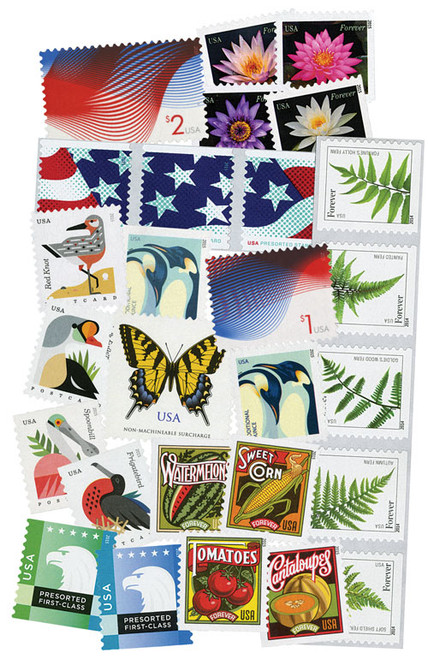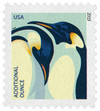
# 4989 - 2015 22c Penguins
U.S. # 4989
2015 22¢ Penguins
Additional Ounce Rate
In 1902, physician and natural historian Edward A. Wilson (1872-1912) became a polar explorer. Hired as a junior surgeon, Wilson joined the British National Antarctic Expedition, which would be the southern-most trek into the Antarctic at the time.
The Discovery Expedition, as it became known, was primarily a quest for scientific knowledge. It was on this journey that the first-known emperor penguin colony was found at Cape Crozier.
Eager to study the penguins, Wilson returned to the Antarctic with the Terra Nova Expedition in 1910. He had a theory that penguin embryos would reveal a link between birds and reptiles. But to get the eggs at the right time, he would need to reach the colony in the middle of winter. Temperatures dipped to 77 degrees below zero on the daunting 60-mile march through constant darkness. It was described by one explorer as “the worst journey in the world.”
Wilson’s successful retrieval of the eggs failed to prove his theory, but his efforts were not in vain. Many of Wilson’s scientific findings are still used as benchmarks for Antarctic study. Collected at the height of the “Heroic Age of Antarctic Exploration,” Edward Wilson’s emperor penguin eggs serve as a reminder of the sacrifices made in mankind’s continuous pursuit of knowledge.
Value: 22¢ Additional Ounce Rate
Issued: June 1, 2015
First Day City: Kansas City, MO
Type of Stamp: Definitive
Printed by: Banknote Corporation of America/Sennett Security Products
Method: Offset with microprinting in sheets of 200 with 10 panes of 20 per sheet
Perforation: Serpentine Die Cut 10 ¾
Self-Adhesive
Quantity Printed: 120,000,000 stamps
Working from sketches and photos from the Central Park Zoo in New York City, artist Nancy Stahl created the Penguins stamp image digitally. Art director Carl Herrman designed the final stamp. This issue marks the second time penguins were featured on U.S. postage. The first was in 1992, when a pair of King Penguins was honored on U.S. #2708.
U.S. # 4989
2015 22¢ Penguins
Additional Ounce Rate
In 1902, physician and natural historian Edward A. Wilson (1872-1912) became a polar explorer. Hired as a junior surgeon, Wilson joined the British National Antarctic Expedition, which would be the southern-most trek into the Antarctic at the time.
The Discovery Expedition, as it became known, was primarily a quest for scientific knowledge. It was on this journey that the first-known emperor penguin colony was found at Cape Crozier.
Eager to study the penguins, Wilson returned to the Antarctic with the Terra Nova Expedition in 1910. He had a theory that penguin embryos would reveal a link between birds and reptiles. But to get the eggs at the right time, he would need to reach the colony in the middle of winter. Temperatures dipped to 77 degrees below zero on the daunting 60-mile march through constant darkness. It was described by one explorer as “the worst journey in the world.”
Wilson’s successful retrieval of the eggs failed to prove his theory, but his efforts were not in vain. Many of Wilson’s scientific findings are still used as benchmarks for Antarctic study. Collected at the height of the “Heroic Age of Antarctic Exploration,” Edward Wilson’s emperor penguin eggs serve as a reminder of the sacrifices made in mankind’s continuous pursuit of knowledge.
Value: 22¢ Additional Ounce Rate
Issued: June 1, 2015
First Day City: Kansas City, MO
Type of Stamp: Definitive
Printed by: Banknote Corporation of America/Sennett Security Products
Method: Offset with microprinting in sheets of 200 with 10 panes of 20 per sheet
Perforation: Serpentine Die Cut 10 ¾
Self-Adhesive
Quantity Printed: 120,000,000 stamps
Working from sketches and photos from the Central Park Zoo in New York City, artist Nancy Stahl created the Penguins stamp image digitally. Art director Carl Herrman designed the final stamp. This issue marks the second time penguins were featured on U.S. postage. The first was in 1992, when a pair of King Penguins was honored on U.S. #2708.










